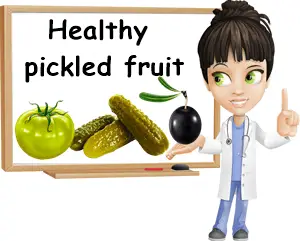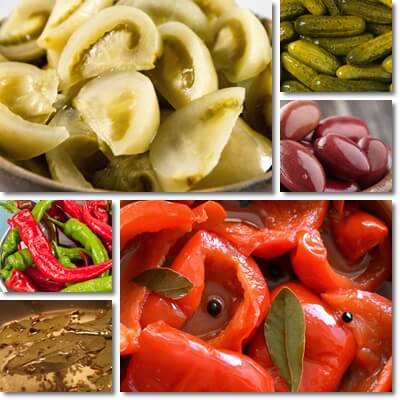While you can technically pickle just about any fruit and vegetable, not all foods lend themselves to pickling equally well, not to mention some fruits and veggies are just healthier eaten fresh. However, these 9 botanical fruits are excellent pickling material, and healthy, providing a range of benefits for gut health, weight loss, blood circulation, eye health, and anti-inflammatory and anticancer properties. Find out what healthy fruits you can pickle and what makes them good for you.
Green tomatoes
Pickled green tomatoes, ‘gogonele’ in Romanian, are the traditional pickles in Romania, and other Balkan countries. Eaten as a side dish to more filling, heavier dishes, pickled tomatoes are made from underripe and often also underdeveloped tomatoes that are completely green. Smaller tomatoes can be pickled whole, while larger ones are cut in quarters or sliced. Pickled green tomatoes are not just a probiotic, but also have scientifically proven anticancer properties.
See the benefits of green tomatoes.

Gogosari peppers
Gogosari peppers are also known as Romanian Gogosari peppers or the Round of Hungary peppers. They are a variety of non-pungent pepper that is quite meaty with a thick flesh and thin skin, lending themselves to pickling well. Cut in halves or quarters (seeds and stem removed), they are pickled with mustard seeds, black pepper, small onions and dill in a water, vinegar and sugar marinade, often in combination with cauliflower florets. Red Gogosari peppers are high in pro-vitamin A carotenoids, while green ones are high in chlorophyll.
Spicy Bulgarian peppers
A variety of Capsicum annuum, spicy Bulgarian peppers are essentially long and thin, pungent peppers, lightly crinkled and curved towards the tip. Spicy Bulgarian peppers are pickled whole and make for a delicious pickle to pair with stewed sour cabbage with pork sausage and polenta. The unripe peppers are a light, yellowish-green, while the ripe ones are a deep red. Pickled spicy Bulgarian peppers are a low-calorie, low-fat food, good for weight loss.
Quinces
Quince season is upon us. If you have too many quinces and have already made all the quince jam you will need to last you until next year, maybe consider pickling your quinces. Cut into thinner pieces or slices, making sure to remove the stem, seeds and seed cavity, then pickle. Pickled quinces make for a good prebiotic and probiotic food, helping feed and enrich good gut bacteria populations for good gut health. Just remember to save some quinces for baking.

Green plums (pitted or not)
Pickled plums can be made from unripe, green plums in general, or varieties of green plum (that produce fruit that are green or yellow-green at maturity). The plums can be pickled whole, with pits, or pitted, and make for an interesting side dish with prebiotic and probiotic benefits. Add pickled plums to beef soup, pair with a warm potato salad with mayonnaise and hard boiled eggs or a leafy green salad with walnuts and cherry tomatoes.
Watermelon rind (with the white part)
Most people only eat the watermelon flesh, but there’s no need to discard the rind either. Clean and portion the watermelon rind with the white part of the watermelon (thin strips that fit your jar look great) and pickle for an interesting side dish to accompany heavier main courses. Both the watermelon rind and the white part of the watermelon rind are sources of citrulline with benefits for blood circulation.
Citron watermelon
Also known as citron melon, the citron watermelon is a variety of watermelon related to the sweet watermelon. It’s typically a greenish-white inside and not very good tasting, but makes a healthy pickle. Portion to your liking and pickle whole (rind, white, part, flesh and seeds), or just the rind with some flesh. Pickled citron watermelon is good for gut flora and gut health, as well as cardiovascular health.
Cucumbers
Cucumbers are the classic pickle, and most gardeners still have cucumbers coming in this October. No matter the variety or size of the cucumbers, you can always pickle them. Smaller cucumbers such as gherkins or cornichon cucumbers can be pickled whole, while larger varieties such as the European or English cucumber are best portioned into moderately thick strips. Pair with dill, mustard seeds and even slices of green tomatoes, carrot circles, or celeriac strips, and a vinegar, oil, salt and sugar marinade. Pickled cucumbers are a source of vitamin K to support blood coagulation, with added anti-inflammatory benefits.
Olives
One of the best pickled fruit, with a smooth oily finish and exquisite flavor. Pickled, cured or brined olives come in a variety of colors, including green, black, red, purple and even yellow. Pickled olives are an important source of vitamin E with antioxidant properties, found to reduce risks of cardiovascular disease, dementia and even some cancers. Olives, especially red, purple, brown and black varieties, are high in anthocyanin antioxidants with scientifically proven anticancer properties. You can stuff your olives with blanched almonds, red bell pepper pieces or walnut kernel quarters for a complimenting crunchy texture.
